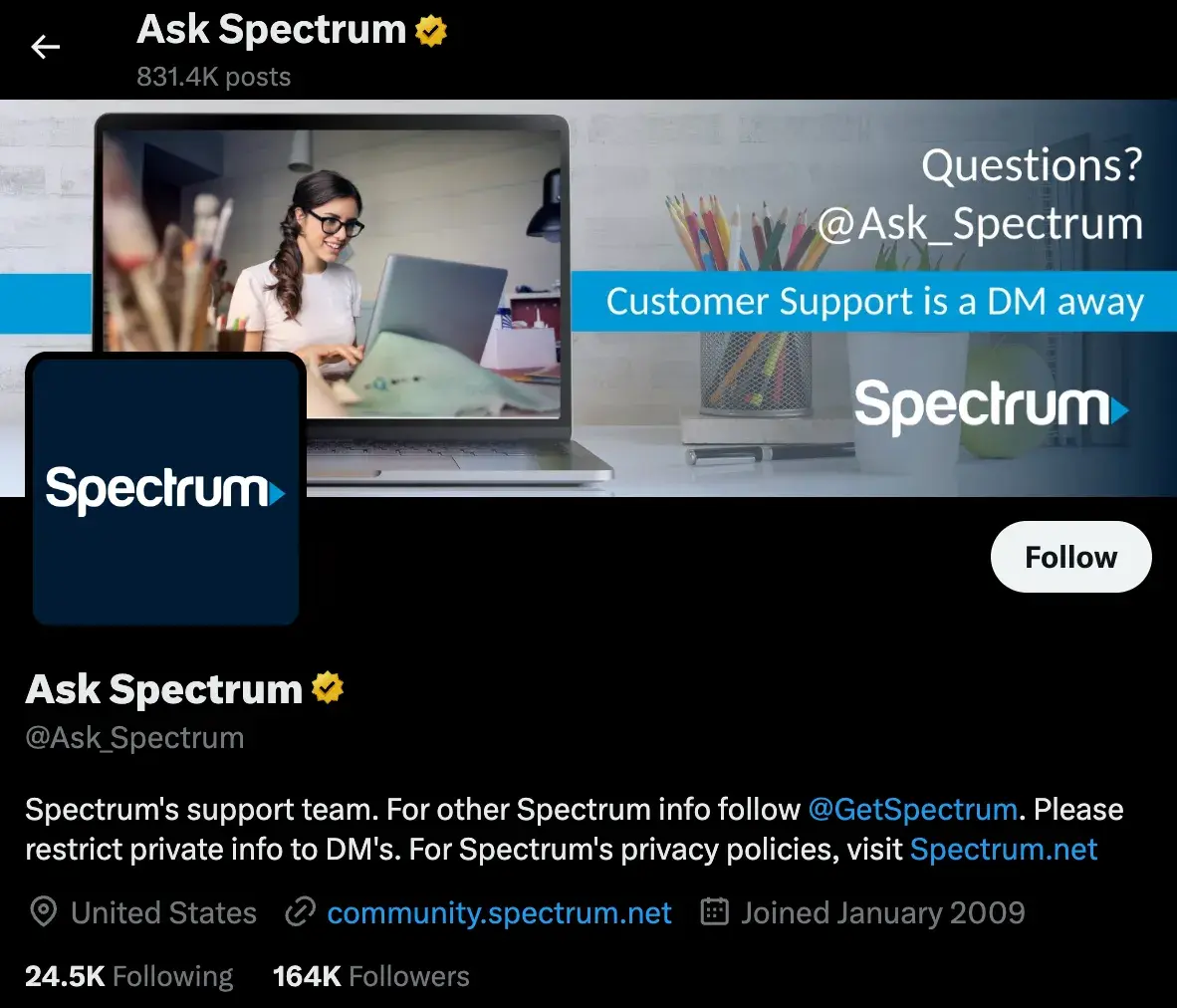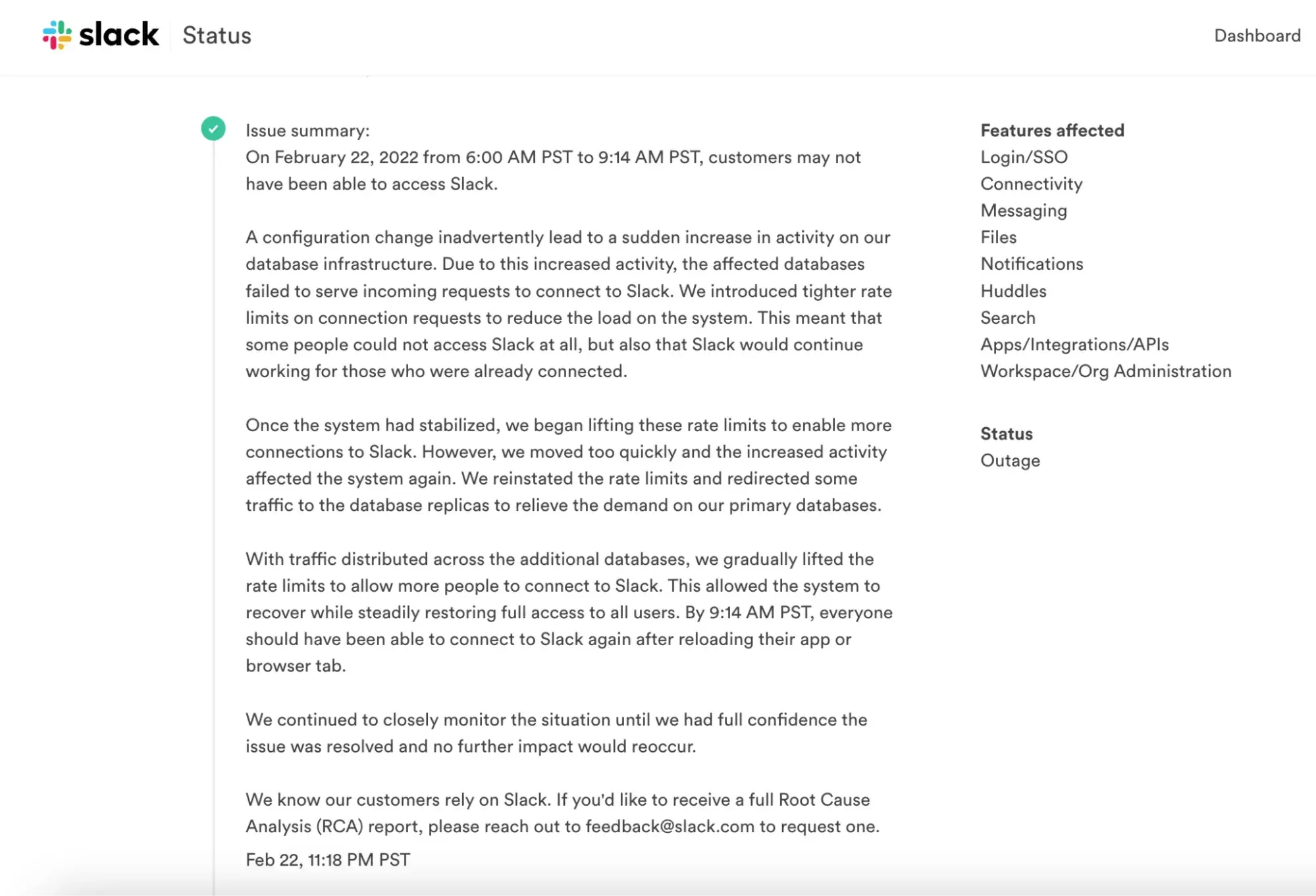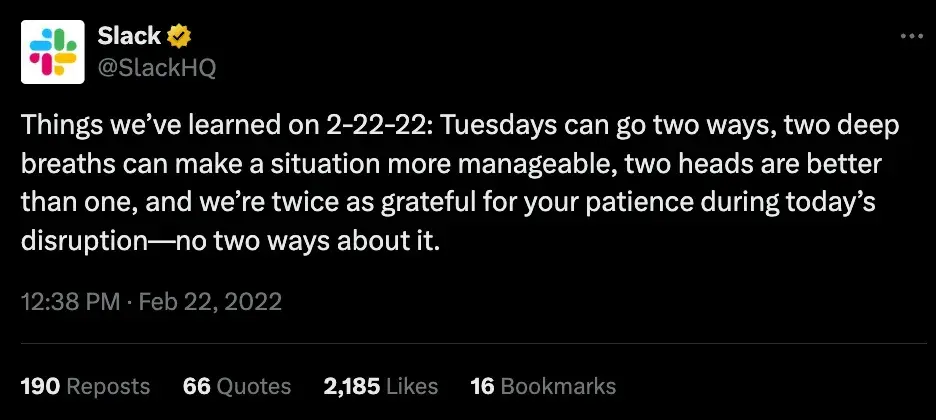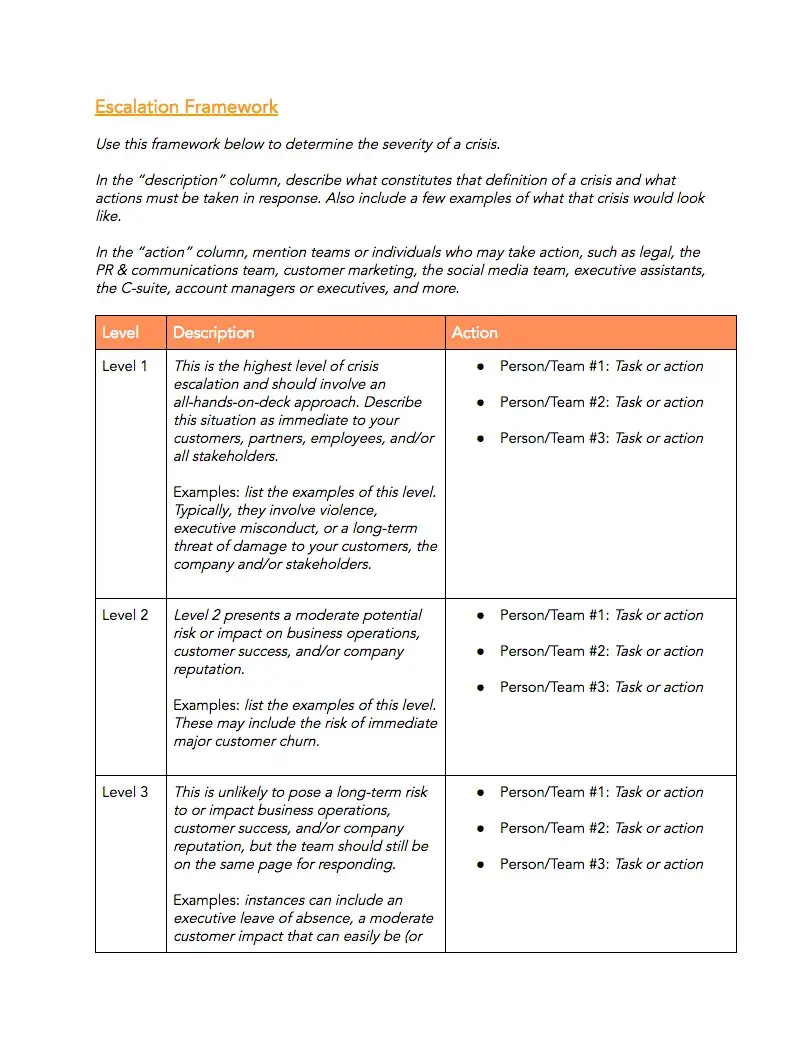Each of these scenarios deserves reasonable and empathetic responses from your brand, but if your team doesn‘t have a framework for what to say, when, or how, they’ll be left floundering.
So, if you're working on a customer service team or handling outbound communications, you need the right answers to communicate with customers during a crisis.

Download the Template for Free
Table of Contents
What is a social media crisis?
I know I’ve seen unfunny and weird tweets from a business before, but not all social media fails constitute a crisis. To that end, not all crisis management stems from a social media faux pas.
However, one thing is clear: When things go south, it's time to implement your social media crisis management plan.
A social media crisis is an online activity that can damage a brand‘s or major stakeholder’s reputation by posting or sharing offensive, distasteful, or even dangerous information.
Social media crises can erupt from a business posting or sharing content that:
- Belittles or mocks a group of people.
- Insensitively uses figures or events to sell products.
- Spreads false or dangerous information.
- Is questionably slanderous.
Beyond posts themselves, social media crises can also include employee misconduct or errors that are then spread online or other happenings that can make headlines for the wrong reasons. Rumors or customer discontent can also spill over into social media, causing a firestorm of fury.
The result of such actions can be a nightmare for any marketing team. Common repercussions include nasty comments from customers, unhappy customers voicing their concerns, and a marketing faux pas permanently documented on the internet even after it's deleted.
And since people make decisions with their pocketbooks, it's absolutely vital that you get out in front of things quickly.
What is not a social media crisis?
Here are a few examples of negative social media actions that are not crises. With good communication practices, you can turn one negative interaction into a positive or at least neutral one.
- A bad online review
- A post that flops
- Rude customer comments
Create an escalation framework in your strategy document so everyone’s clear what is a crisis— and what isn’t.
Social Media Crisis Management
Whether a crisis occurs online or IRL, you can expect a social media response from your customers. And they expect to hear from you immediately. 72% of CCOs/CMOs say that stakeholders expect immediate action in a crisis.
Social media is becoming the preferred method of communication because it empowers consumers to post a review instantly for all their (and your) followers to see. If your brand makes a mistake, customers will quickly take to their phones to tweet or post about the issue.
These comments can snowball and escalate a problem into an alarming crisis. To that point, 36% are likely to share a negative experience with a friend or family member if it isn’t resolved in 24 hours. This is why it's important to have a plan in place.
Benefits of Social Media Crisis Management
The good news is that social media can be a powerful tool for managing a business crisis. You can also try out social media management software to save time and help you prioritize your social interactions.
Mass Distribution
Social media allows you to communicate with nearly your entire customer base over one or two platforms. Your company can quickly broadcast a message and get ahead of a crisis when needed.

To that end, by also including how you plan to do better, you build trust with your audience.
Midwest utility WE Energies had an unexpected disruption to power and immediately shared a critical request to social media.
They used the above Facebook post to keep their customers informed, updating it as more information became available.
After publishing, they were able to get notices to the media and customers via email and text. (The shortage was resolved the following morning.)
Personalized Messaging + Problem-Solving
Social media allows you to speak directly with customers using direct messaging or commenting. If one customer has an issue, your customer service team can respond instantly through private or public messages.
If the customer posts publicly on your timeline, an effective response from your customer service team can be a positive example of your team's credibility.

Many brands take to Facebook and Twitter messaging to handle problems in addition to traditional channels.
Spectrum is one of many that people can message to get quick, convenient, and effective responses to their questions or concerns.
Create Transparency
When I read a jaw-dropping news story about a brand, social media is the first place I go to see how the brand will respond. And brands that do social media well capitalize on the opportunity to build trust by delivering transparency to their audience.

Southwest Airlines is well known for using social media to communicate with their customers, delivering updates, and giving them information about where to go for more information.
Now that you know how proper management can impact a company, we'll break down how your business can create a crisis contingency plan and integrate it into your customer service team.
But before diving in, I have a free resource to help you prepare for almost any crisis.
Social Media Crisis Management Plan Template
From negative comments to natural disasters, it's essential to have a proper response plan for your social media channels. This guide will help you solve tough problems quickly while avoiding damage to your company's reputation.
In this free PDF guide and Excel template, you'll learn:
- How to become an expert problem solver
- The differences between a problem and a crisis
- What to do when a problem becomes a crisis
- How to create your very own crisis management plan
How to Create a Social Media Crisis Management Plan
Whatever the crisis, a social media crisis management plan is essential to your team's success. Choose a leader to own the plan and invite different functions like customer service, marketing, public relations, human resources, and legal to collaborate.
Once developed, incorporate the plan into your training and onboarding so all employees know and can follow the protocols.
What to Include in a Social Media Crisis Management Plan
Wondering what to include? Here are the different components your crisis management plan should contain, from pre-crisis to post-crisis.
Team Roles and Access

Long before a crisis hits, you need to know who will be managing the crisis. Define roles and responsibilities for all staff involved, including daily social media managers. Define how you will secure and manage admin access to your accounts, especially when a key employee leaves.
“It's crucial to have a small team of leaders who are capable of handling a crisis, in case one arises,” advised Seth Besse, CEO of Undivided.io. “Knowing which team member will guide and monitor the crisis, who will manage the response across channels, and who will keep leadership informed allows your company to respond quickly and effectively.”
Brand Controls
While it may exist in a separate document, every brand should have brand and voice guidelines that inform their social media strategy. Knowing these guidelines inside and out, and setting internal controls where a second set of eyes reviews content before it’s published, can avoid many social media blunders.
“Our role is to catch those issues and know when we see something or someone says, ‘I’ve got this brilliant idea,’” said Barnaby Hardy-Bray, senior account director at The Social Shepherd. “I might see something and say, ‘That’s totally against brand guidelines,’ or ‘That might provoke a reaction with our audience.’ We sit in the middle between our teams, and it enables us to be that brand guardian.”
Set a content review workflow to minimize the chance of starting a crisis with an off-brand or offensive post.
Detection and Escalation Framework

In your social media crisis plan, document how accounts are monitored, including outside of business hours. Then, give guiding criteria for what defines a crisis. That way, you have a framework to assess and decide when to trigger an escalation. It’s helpful to frame this in terms of multiple crisis levels with different responses warranted.
Crisis Protocol

Next, create recommended actions that correspond to the level of crisis. This might include alerting leadership, pausing marketing campaigns, assigning extra staff to respond to customers, or releasing a statement.
List a crisis response team outside of the daily social media team who will need to weigh in on a crisis. List the best communication method for the response team.
Crisis Communications Guiding Principles

Before knowing what a specific crisis is, you can prepare by writing down your guiding principles in a crisis. For example, will you lean into transparency or confidentiality? Who is authorized to speak to the media? Having some of this language outlined ahead of time will help you pivot quickly and stick to your brand and values.
Templated Responses

With certain issues, you can create a templated response to adapt to any scenario. If you have a policy about commenting on personal issues or ongoing lawsuits, for instance, work with your legal team to write generic response statements.
Post-Crisis Review

Once a crisis has passed, there’s still work to do. Gather your team to grade yourselves on key points of your response, like promptness and sincerity. Take a sentiment analysis of social media discussions to see how customers feel about the issue and if that changed throughout your response. Use our post-crisis grading template to review how you performed and how you can improve in the future.
I find that case studies are useful to learn from how others handle a crisis. In the next section, I’ll highlight some notable social media crises that affected businesses and how they responded.
Social Media Crisis Examples
Big and small brands are susceptible to crises that can significantly impact their reputations. Some of these happen in the social media realm, like a user spreading a rumor about your company. Others happen in the real world, like a natural disaster or cybersecurity attack.
Here are a few real-life social media crises that businesses recently faced. The most common crises, according to Edelman, are:
- Online and social media attacks.
- Supply chain issues and disruptions.
- Talent shortages/labor-related issues.
- Issues related to diversity and inclusion.
- Issues related to climate and the environment.
- Activism and protests.
Here are three recent examples companies have faced.
1. Undermining Customers
U.S.-based event management company Ticketmaster manages a significant percentage of ticket sales in the country.
When Taylor Swift, one of the decade's biggest stars, put tickets for her 2023 tour up for pre-sale, disaster struck.
Widespread reports surfaced of fans not being able to finalize their purchases, with the company crashing during checkout.
Because the company managed the pre-sale codes, they had advance notice of how many people would be seeking tickets, and they ultimately failed.
A huge public outcry prompted an antitrust probe and an angry Instagram post from Swift.

2. Inappropriate Marketing Messages
High-profile fashion brand Balenciaga came under fire for its ads featuring children holding teddy bears in highly sexualized attire. Because this came on the heels of a scandal with Kanye West, it did further damage to the brand.
In addition to pulling the ads and apologizing for them, the brand admitted to a severe miscalculation and agreed that the campaign was offensive. However, they were slow to take action and filed a lawsuit against the photographer.

3. Distasteful Comments From an Executive
There is no better example of this than Elon Musk's takeover of X, then known as Twitter.
In addition to making wild assumptions and accusations before and after purchasing the social media platform, his sweeping staffing cuts and other gaffes caused calls to boycott X.
The ongoing controversy continues with chaotic product releases, the development of a “hardcore” work culture where employees are expected to sleep onsite, and more.
In addition to Musk's reputation taking a nosedive, X lost credibility, and Musk’s other business Tesla was put under the microscope.

Successful social media crisis management begins with developing a strategy that proactively prepares for potential problems.
Social Media Crisis Management Examples
Despite everything that can go wrong, a lot is still in your control. Learn from these companies who show how they have it handled.
Slack's Outage Response
Slack is a popular online messaging platform that experienced a huge outage in February 2022. During the outage, they published frequent updates to keep people in the loop.

The brand also went to Twitter to share a lighthearted yet deeply sincere apology.

Why It Worked
Slack was incredibly transparent during the problems. They acknowledged what was happening, kept their audience in the loop, and followed through until it was resolved.
What's more, they followed up publicly after the fact with a sincere apology that I loved.
Burger King — Who belongs in the kitchen?
On International Women's Day, Burger King UK posted a cringeworthy tweet, “Women belong in the kitchen.” Unsurprisingly, this led to a huge uproar on social media, with people questioning who authorized this post.

Burger King immediately took action, deleting the post and publishing the below apology:

Why It Worked
While the gaffe was certainly offensive for many (including me), by taking ownership of their mistake, Burger King was able to head off the PR nightmare that it could have been.
Moreover, their heartfelt apology and explanation of what they intended to say helped.
People miscommunicate all the time, and people were more or less forgiving of Burger King. However, their commitment to learn from their mistakes was the icing on the cake.
10 Social Media Crisis Management Tips
1. Protect and restrict social media login information.
This may seem like a no-brainer, but crises can arise when an account gets into the hands of the wrong people. A 2023 Norton Cyber Safety Report claims that 13% of social media users have dealt with unauthorized activity on their accounts, and 15% have had personal information exposed in a breach.
Pro Tip: Ensure your marketing team is taking precautions to minimize this risk and have a message ready to share when the account has been reclaimed.
2. Engage in social listening.
A social media crisis is daunting, and many social media managers spring immediately into action without taking time to listen and learn. Your audience may be saying exactly what your team needs to hear to remedy the situation.
Active listening can also extend internally: “We need to be paying attention to what our audience is saying and what our customers are saying, but it’s also about listening to what other stakeholders are saying within the business,” recommended Hardy-Bray.
Check your ego at the door, monitor responses, bring feedback and recommendations to leadership, and see how you can combine user suggestions with meaningful action.
Pro Tip: Create an action plan based on these suggestions and tell your audience how you're adapting them.
3. Pause any scheduled social media campaigns.
Before a crisis is resolved, your marketing team must halt its scheduled campaigns. Nothing comes off as more tone-deaf than promoting a product while failing to acknowledge a serious problem.
All further communication must be planned, consistent, and appropriate in tone. And a pre-scheduled post won't fulfill those criteria.
Pro tip: It's not enough to simply pause campaigns. Revisit everything you have planned to ensure that it’s appropriate in context.
4. Learn from it and add guidelines for future social media usage.
The biggest takeaway from any crisis is that you should work to prevent it from happening again.
Reflect on the successes and pitfalls of your marketing and service teams' crisis management. By sharing takeaways with different stakeholders, you can devise social media crisis management plans that will prepare your business for anything that may arise.
Pro tip: Your lessons can serve as an opportunity to forge better relationships with your audience. Consider creating a social post about what you learned and how you adapted to build trust.
5. Respond quickly, but not too quickly.
You have to move fast to get in front of the crisis to show you‘re aware and taking steps to mitigate it. That means you don’t want to sit on the sidelines while the problem grows and wait to take action until it's a full-blown crisis.
However, you don‘t have to put together a post the second you hear about it. Instead of a knee-jerk reaction, evaluate the situation and think about your response so you don’t exacerbate the situation.
One example of this is Indiana University, which like many organizations, issued a statement of sympathy following the October 2023 attack in Israel. The statement didn’t mention Israel by name and garnered significant backlash from alumni and faculty groups for being too vague and not condemning the violence in strong terms. IU President Pamela Whitten had to quickly issue another statement with clearer language.
Pro tip: Create a fill-in-the-blank template you can use to create an initial response post, even if it‘s simply acknowledging the situation, stating that you’re investigating it, and will update soon. It may not work for every situation, but it gives you a starting point.
6. Prioritize transparency.
After realizing there‘s a problem, formulate your response. Let your audience know as soon as possible that you’re aware of the situation and what you're doing about it.
Even if the first step is to investigate the problem, that's an exceptional first step. Tell them where they can get updates and how frequently to expect them. Then follow through.
Transparency builds trust.
Pro tip: Consider a specific page on your website that you can update frequently. Even if your social media account doesn't get updated every 15 minutes, your audience still has somewhere to look for updates.
7. Be authentic.
Your audience knows when you're paying lip service to placate them. The beauty of social media is that it allows you to be more personal. So, use this to share your true apologetic feelings and appreciation for your audience.
Pro tip: If it's appropriate to incorporate a dose of humor (especially the self-deprecating variety), you can build empathy and understanding with your company.
8. Don't assign blame elsewhere.
Above all, you must take responsibility for the problem. A critical part of your social media crisis management plan should include how you'll acknowledge fault.
After all, apologies that start “We're sorry, but…” lose trust and build angst faster than almost anything else you can say. Instead of passing the buck, a simple “We screwed up. Please forgive us?” can go a long way toward beginning to repair the damage.
“It‘s easy to make mistakes, but it’s harder to recover from them if you try to cover up or lie about what happened,” shared Gauri Manglik, CEO and co-founder of Instrumentl. “People appreciate honesty, and they'll respect you for being willing to admit your mistakes.”
Pro tip: Include how you plan to do better, which helps you build trust with your audience.
9. Engage with your audience.
You probably can't respond to every comment mid-crisis because your team will be all hands on deck to resolve it. However, as time allows, engage with your audience as much as possible.
Pro tip: Don't simply post a blanket statement with every response. Instead, by taking a moment to acknowledge and empathize with the comments you do respond to, you can personalize your response and show your audience that you really do care.
10. Communicate internally as well as externally.
It‘s absolutely essential to keep your audience in the loop. However, there’s another group of people you can't forget — yours.
Your customer service team is on the front lines of customer responses to the crisis, and you need to equip them with the tools they need to handle the situation.
One of those tools is accurate information. The only thing worse than misinformation spread by people outside your company is when it's spread by people on your team — internally as well as to your customers.
Failing to include updating your internal team in your social media crisis management plan is simply not an option. It's a recipe for disaster.
Pro tip: To head off an internal crisis and the one you're handling, give your team information, tell them what they can share, and present them with language to share it. Doing so ensures that everyone on your team contributes to a consistent message and will help get your brand on track.
Make Your Crisis Plan Before You Need It
In a social media crisis, I’ve learned (sometimes the hard way) to monitor and listen, respond quickly, embrace transparency, and stay flexible.
Owning responsibility for the action, apologizing, and perhaps poking fun at yourself (if appropriate) can help your customer service teams respond to incoming inquiries as quickly and effectively as possible.
Your social media crisis management plan isn‘t just a nice, shiny tool in your toolbox. It’s a must in today's social media-centric world.
Editor's note: This post was originally published in May 2015 and has been updated for comprehensiveness.
Public Relations
.png?width=112&height=112&name=Image%20Hackathon%20%E2%80%93%20Vertical%20(61).png)

.png)
